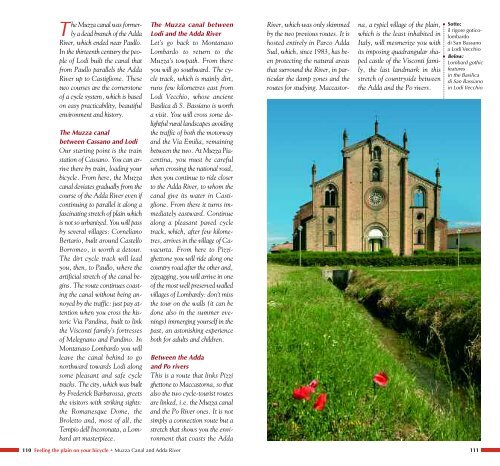mastro Orso
mastro Orso
mastro Orso
You also want an ePaper? Increase the reach of your titles
YUMPU automatically turns print PDFs into web optimized ePapers that Google loves.
The Muzza canal was formerly<br />
a dead branch of the Adda<br />
River, which ended near Paullo.<br />
In the thirteenth century the people<br />
of Lodi built the canal that<br />
from Paullo parallels the Adda<br />
River up to Castiglione. These<br />
two courses are the cornerstone<br />
of a cycle system, which is based<br />
on easy practicability, beautiful<br />
environment and history.<br />
The Muzza canal<br />
between Cassano and Lodi<br />
Our starting point is the train<br />
station of Cassano. You can arrive<br />
there by train, loading your<br />
bicycle. From here, the Muzza<br />
canal deviates gradually from the<br />
course of the Adda River even if<br />
continuing to parallel it along a<br />
fascinating stretch of plain which<br />
is not so urbanized. You will pass<br />
by several villages: Corneliano<br />
Bertario, built around Castello<br />
Borromeo, is worth a detour.<br />
The dirt cycle track will lead<br />
you, then, to Paullo, where the<br />
artificial stretch of the canal begins.<br />
The route continues coasting<br />
the canal without being annoyed<br />
by the traffic: just pay attention<br />
when you cross the historic<br />
Via Pandina, built to link<br />
the Visconti family’s fortresses<br />
of Melegnano and Pandino. In<br />
Montanaso Lombardo you will<br />
leave the canal behind to go<br />
northward towards Lodi along<br />
some pleasant and safe cycle<br />
tracks. The city, which was built<br />
by Frederick Barbarossa, greets<br />
the visitors with striking sights:<br />
the Romanesque Dome, the<br />
Broletto and, most of all, the<br />
Tempio dell’Incoronata, a Lombard<br />
art masterpiece.<br />
110 Feeling the plain on your bicycle • Muzza Canal and Adda River<br />
The Muzza canal between<br />
Lodi and the Adda River<br />
Let’s go back to Montanaso<br />
Lombardo to return to the<br />
Muzza’s towpath. From there<br />
you will go southward. The cycle<br />
track, which is mainly dirt,<br />
runs few kilometres east from<br />
Lodi Vecchio, whose ancient<br />
Basilica di S. Bassiano is worth<br />
a visit. You will cross some delightful<br />
rural landscapes avoiding<br />
the traffic of both the motorway<br />
and the Via Emilia, remaining<br />
between the two. At Muzza Piacentina,<br />
you must be careful<br />
when crossing the national road,<br />
then you continue to ride closer<br />
to the Adda River, to whom the<br />
canal give its water in Castiglione.<br />
From there it turns immediately<br />
eastward. Continue<br />
along a pleasant paved cycle<br />
track, which, after few kilometres,<br />
arrives in the village of Cavacurta.<br />
From here to Pizzighettone<br />
you will ride along one<br />
country road after the other and,<br />
zigzagging, you will arrive in one<br />
of the most well preserved walled<br />
villages of Lombardy: don’t miss<br />
the tour on the walls (it can be<br />
done also in the summer evenings)<br />
immerging yourself in the<br />
past, an astonishing experience<br />
both for adults and children.<br />
Between the Adda<br />
and Po rivers<br />
This is a route that links Pizzi<br />
ghettone to Maccastorna, so that<br />
also the two cycle-tourist routes<br />
are linked, i.e. the Muzza canal<br />
and the Po River ones. It is not<br />
simply a connection route but a<br />
stretch that shows you the environment<br />
that coasts the Adda<br />
River, which was only skimmed<br />
by the two previous routes. It is<br />
hosted entirely in Parco Adda<br />
Sud, which, since 1983, has been<br />
protecting the natural areas<br />
that surround the River, in particular<br />
the damp zones and the<br />
routes for studying. Maccastorna,<br />
a typicl village of the plain,<br />
which is the least inhabited in<br />
Italy, will mesmerize you with<br />
its imposing quadrangular shaped<br />
castle of the Visconti family,<br />
the last landmark in this<br />
stretch of countryside between<br />
the Adda and the Po rivers.<br />
• Sotto:<br />
il rigore goticolombardo<br />
di San Bassano<br />
a Lodi Vecchio<br />
• Below:<br />
Lombard gothic<br />
features<br />
in the Basilica<br />
di San Bassiano<br />
in Lodi Vecchio<br />
111
















